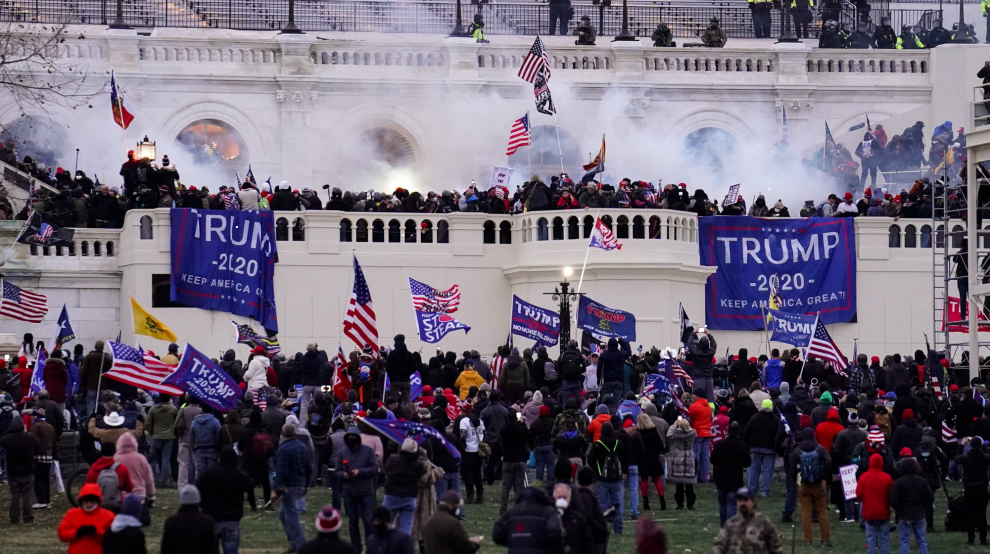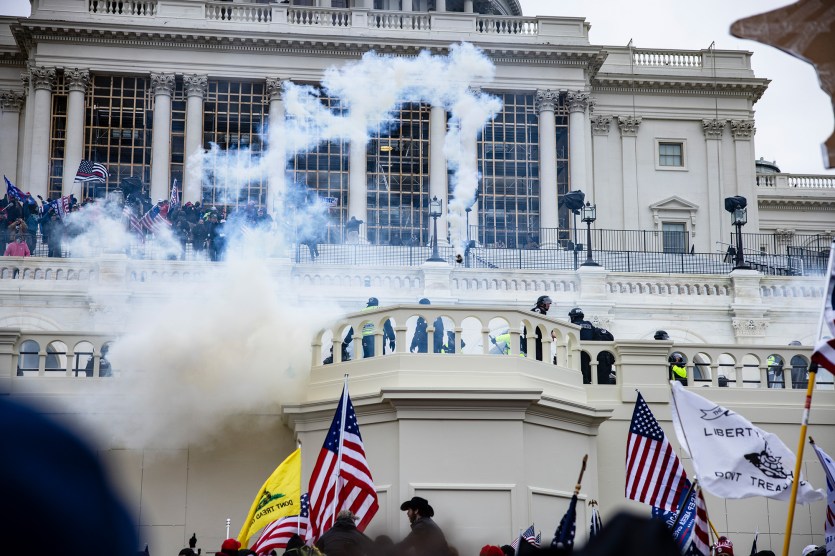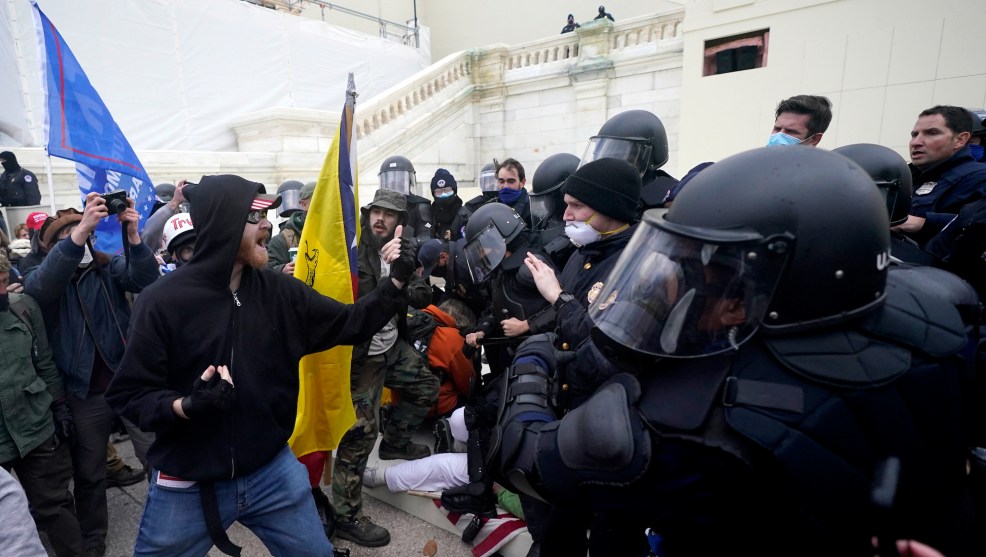
John Minchillo/AP
On Tuesday morning, the House select committee investigating the insurrectionist January 6 assault on the US Capitol launched its hearings. The panel—which the House Republican caucus boycotted—opened with law enforcement officers who were attacked by the pro-Trump crowd of white supremacists, neo-Nazis, Christian nationalists, QAnoners, and other extremists. The point: to counter Donald Trump and his cult’s whitewashing disinformation that the 1/6 gathering, as Trump had put it, was a “loving” assembly. This part of the committee’s mission is not that hard. It need only replay the thousands of videos from that horrific day—or the disturbing collection produced by the New York Times— to disprove the GOP BS that the rioters acted like tourists and did little wrong. And Rep. Bennie Thompson (D-Miss.), the chair of the committee, at the beginning of the hearing cued up a compilation of harrowing footage from the attack. The police witnesses watched with haunted gazes.
The much tougher task for the committee will be investigating what Trump and his minions did in the months, weeks, days, and even hours leading up to the assault and what actions Trump and his aides took (or didn’t take) during the seditious riot. These are key elements of the inquiry, and this is the part of the story that Trump and his henchmen do not want to be probed and publicized. Moreover, most of the witnesses to these behind-the-scenes truths are Trump devotees. It was no surprise that the GOP has tried to thwart a 1/6 investigation. A thorough probe would place many prominent Republicans, including members of Trump’s inner circle and his family, in an inconvenient position by demanding from them testimony that would likely not cast Trump in a positive light.
It’s unclear at this point whether the committee will pursue such testimony and how top Trump loyalists will respond if called to appear before the committee. A battle royale could be in the making, testing congressional power. Here’s a partial list of GOPers who ought to be hauled in by the 1/6 select committee. No doubt, its investigators will find others who should be questioned. But as this roster shows, the committee is starting out with a clear and extensive roadmap.
- Former Rep. Mark Meadows (R-N.C.). He was Trump’s White House chief of staff at the time and can explain what was happening at 1600 Pennsylvania during the violent raid on Congress. That includes Trump’s own actions during the assault he incited. Was Trump really excited, as CNN reported, to watch the violent throng try to stop the certification of the 2020 election
- Reps. Paul Gosar (R-Ariz.), Andy Biggs (R-Ariz.), and Mo Brooks (R-Ala.). Ali Alexander, an organizer of the pro-Trump “Stop the Steal” movement, says that he worked with this trio of Trump devotees to create an event on January 6 that would put “maximum pressure” on Congress when it was voting to certify Joe Biden’s Electoral College victory. All three members should be grilled under oath. (Biggs and Brooks have denied this.)
- Rep. Kevin McCarthy (R-Calif.). The House Republican leader reportedly had an angry, expletive-laced phone conversation with Trump during the attempted insurrection, and Trump indicated he would not call off the rioters. What truly occurred during this call?
- Kimberly Guilfoyle. On the night of January 5, according to Alexander, he spoke with Guilfoyle, a former Trump campaign official and the girlfriend of Donald Trump Jr., and he suggested that she had encouraged him. What exactly did she say to him? Was she conveying a message from anyone else?
- Caroline Wren, who was a deputy to Guilfoyle at Trump Victory, a joint presidential fundraising committee during the 2020 campaign, was reportedly involved in the planning of the rally near the White House that preceded the violent storming of the Capitol. So was Katrina Pierson, who was a national spokesperson for Trump’s 2016 campaign and a senior adviser to the Trump 2020 reelection bid. Pierson was a liaison between the White House and the conservative groups that organized that pre-attack gathering. How closely was the White House involved in that production and the subsequent march that led to the rampage? What did it and the organizers of these events know about the violent plans and inclinations of many of the attendees?
- Roger Stone. Prior to the January 6 attack, Trump’s longtime adviser was repeatedly seen with people subsequently charged in the assault and accused of conspiring to mount the raid. In fact, several of them were providing security for him. Stone also worked to raise money for “private security” and equipment for events in Washington, on January 5 and 6, that preceded the raid on the Capitol. (Warning to the committee: Stone was convicted of lying to Congress. His three-year-plus sentence was commuted by his pal Trump.)
- Rudy Giuliani. The onetime personal lawyer and dirt-digger for Trump—whose Manhattan home and Park Avenue office were raided by the FBI—gave one of the most fiery speeches at the pre-riot rally. “Let’s have trial by combat,” he urged the crowd shortly before large parts of the audience headed toward Capitol Hill.
- Jared Kushner and Ivanka Trump. During the riot, McCarthy appealed to Kushner, Trump’s son-in-law and top aide, for help in stopping the assault, and Sen. Lindsey Graham (R-S.C.) phoned Ivanka Trump, the president’s daughter, to ask for assistance. What do this royal couple of Trumpland know about what occurred in the White House while the Trump mob was ransacking Congress? Ivanka was in the Oval Office at the time. Graham, too, should be questioned about his call to her.
- Sen. Tommy Tuberville (R-Ala.). As the riot on Capitol Hill raged, Tuberville received a call from Trump. (Trump apparently phoned Sen. Mike Lee, the Utah Republican, by mistake while trying to reach Tuberville.) Presumably, Trump was reaching out to Tuberville about the ongoing GOP effort to challenge the certification of Biden’s victory. Tuberville has said he doesn’t remember all the details of the conversation. Really? He should give testimony.
- Kellyanne Conway. The former Trump White House senior adviser called an aide who was standing at the president’s side while the attack was underway. What did she learn?
- Kayleigh McEnany. Then the White House press secretary, McEnany was reportedly with Trump during the attack and implored him to speak out against the violence. How did Trump respond?
- William Barr. Trump’s guard-dog attorney general refused to join Trump in barking false claims of election fraud. He told Trump in early December that the Justice Department had not uncovered any evidence to back up the president’s wild allegations of a stolen election, and this led to an end of their once-beautiful relationship. The House committee—and the public—should hear directly from Barr regarding what Trump was saying to him during the post-election stretch and what he wanted Barr to do.
- Pat Cipollone. Trump’s White House counsel while Trump was attempting to overturn the election results, Cipollone ought to be questioned about all the schemes Trump was discussing or considering to defy the democratic process. Might Cipollone try to hide behind a legal privilege? Perhaps. But it’s worth a shot. Meanwhile, the committee should also haul in Jeffrey Rosen, the acting attorney general after Barr fled, and Jeffrey Clark, who was a senior Justice Department official in the final days of Trump’s presidency, and ask them about Trump’s efforts to get Clark to find a way to invalidate the election results in Georgia and keep Trump in office.
- Mike Pence. The former vice president was the target of some of the rioters, who called for him to be hanged. While in hiding, Pence received calls from congressional leaders who were angry the National Guard had not been deployed. According to the Washington Post, he “spoke with legislative and military leaders, working to mobilize the soldiers and offering reassurance.” He never talked to Trump during the attack. But Marc Short, Pence’s chief of staff, was in contact with the White House. The ex-veep should have a lot to say—and so should Short.
- Donald Trump. Because it was his riot.








